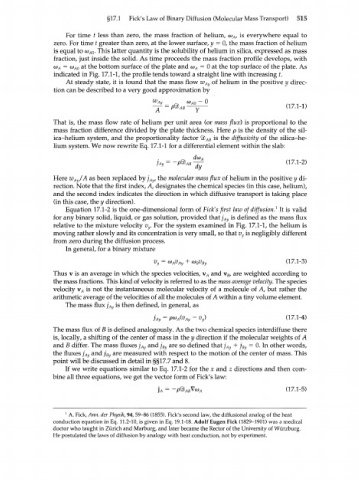Page 535 - Bird R.B. Transport phenomena
P. 535
§17.1 Fick's Law of Binary Diffusion (Molecular Mass Transport) 515
For time t less than zero, the mass fraction of helium, co , is everywhere equal to
A
zero. For time t greater than zero, at the lower surface, у = 0, the mass fraction of helium
is equal to (o . This latter quantity is the solubility of helium in silica, expressed as mass
A0
fraction, just inside the solid. As time proceeds the mass fraction profile develops, with
<°A = 440 a t the bottom surface of the plate and CJ = 0 at the top surface of the plate. As
A
indicated in Fig. 17.1-1, the profile tends toward a straight line with increasing t.
At steady state, it is found that the mass flow w of helium in the positive у direc-
Ay
tion can be described to a very good approximation by
^ = Э л е ^ (17.1-1)
That is, the mass flow rate of helium per unit area (or mass flux) is proportional to the
mass fraction difference divided by the plate thickness. Here p is the density of the sil-
ica-helium system, and the proportionality factor ЯЬ is the diffusivity of the silica-he-
АВ
lium system. We now rewrite Eq. 17.1-1 for a differential element within the slab:
]Ау=-р®Ав^ П7.1-2)
Here w /A as been replaced by j , the molecular mass flux of helium in the positive у di-
A y
Ay
rection. Note that the first index, A, designates the chemical species (in this case, helium),
and the second index indicates the direction in which diffusive transport is taking place
(in this case, the у direction).
Equation 17.1-2 is the one-dimensional form of Fick's first law of diffusion} It is valid
for any binary solid, liquid, or gas solution, provided that j is defined as the mass flux
A y
relative to the mixture velocity v . For the system examined in Fig. 17.1-1, the helium is
y
moving rather slowly and its concentration is very small, so that v is negligibly different
y
from zero during the diffusion process.
In general, for a binary mixture
v y = co v + o v (17.1-3)
A Ay
B By
Thus v is an average in which the species velocities, v A and v , are weighted according to
B
the mass fractions. This kind of velocity is referred to as the mass average velocity. The species
velocity v A is not the instantaneous molecular velocity of a molecule of A, but rather the
arithmetic average of the velocities of all the molecules of A within a tiny volume element.
The mass flux j is then defined, in general, as
A y
JAy = P^A^Ay ~ V y ) (17.1-4)
The mass flux of В is defined analogously. As the two chemical species interdiffuse there
is, locally, a shifting of the center of mass in the у direction if the molecular weights of A
and В differ. The mass fluxes j and j are so defined that j A y + j B y = 0. In other words,
B y
A y
the fluxes j and j are measured with respect to the motion of the center of mass. This
A y
B y
point will be discussed in detail in §§17.7 and 8.
If we write equations similar to Eq. 17.1-2 for the x and z directions and then com-
bine all three equations, we get the vector form of Fick's law:
U = -P®ABVO>A (17.1-5)
1 A. Fick, Ann. der Physik, 94, 59-86 (1855). Fick's second law, the diffusional analog of the heat
conduction equation in Eq. 11.2-10, is given in Eq. 19.1-18. Adolf Eugen Fick (1829-1901) was a medical
doctor who taught in Zurich and Marburg, and later became the Rector of the University of Wurzburg.
He postulated the laws of diffusion by analogy with heat conduction, not by experiment.

